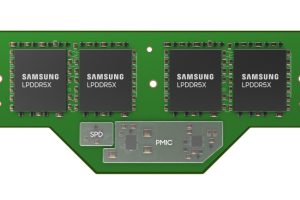JEDEC has published a new JESD318 Compression Attached Memory Module (CAMM2) Common Standard, which defines the electrical and mechanical requirements for Compression-Attached Memory Modules. It covers both Double Data Rate, Synchronous DRAM Compression-Attached Memory Modules (DDR5 SDRAM CAMM2s) and Low Power Double Data Rate, Synchronous DRAM Compression-Attached Memory Modules (LPDDR5/5X SDRAM CAMM2s). The standards body highlights that DDR5 and LPDDR5/5X ...
Tag Archives: dram
Micron samples 9.6Gbit/s LPDDR5X memory for Snapdragon 8 Gen 3
Micron Technology is shipping samples of its LPDDR5X (low-power double data rate 5X) memory for use with Snapdragon 8 Gen 3 – Qualcomm’s new flagship processor for phones. “Running at the world’s fastest speed grade of 9.6Gbit/s, Micron LPDDR5X provides the mobile ecosystem with the performance needed to unlock generative artificial intelligence at the edge,” claimed Micron. This speed compares ...
LPDDR5X interface IP works up to 8.55Gbit/s
Cadence Design Systems has announced LPDDR5X memory interface intellectual property designed to operate at 8,533Mbit/s, claiming it to be the first. Based on its LPDDR5 and GDDR6 products, the IP has a PHY and a controller, designed to follow the JEDEC JESD209-5B standard. The controller-PHY interface is based on the latest DFI 5.1 specification, and a variety of on-chip buses ...
Glasgow transistor improves margins in DRAM
“More than 50% reduction of the statistical variability compared to bulk mosfets with identical dimensions”, is the claim of Glasgow-based Semiwise for its ‘flat field transistor’, which “is complemented by 30% performance increase and 5% reduction of the manufacturing costs compared to the equivalent bulk CMOS technology transistors.” The company is aiming its flat field transistor (right) at the sense ...
DRAM replacement unveiled
Unisantis Electronics of Singapore has unveiled Dynamic Flash Memory (DFM) – a faster and denser technology than DRAM or other types of volatile memory. Unisantis, founded in 2008 by the inventor of flash technology Fujio Masuoka, has patented surround gate transistor (SGT) technology, a 3D transistor design which offers significant system design and performance advantages to the manufacturers of memory and image ...
DDR5 in RDIMMs, UDIMMs and SODIMM start at 16Gbyte
Smart Modular Technologies has launched a DDR5 module family. With a 4.8 to 6.4Gbit/s data rate, DDR5 provides twice the performance of DDR4, as well as improved power efficiency through an on-DIMM 12V voltage regulator and 1.1V I/O. With a dual-channel DIMM topology for higher channel efficiency, according to Smart, it is suited to cloud computing and enterprise networking. “As ...
GDDR6 to overtake GDDR5 in Q4 driven by the Big 3 producers
GDDR6 graphic DRAM will overtake GDDR5 in Q4 to account for more than 60% of total graphics DRAM bit output, says TrendForce. The lowered production capacity and high demand have resulted in a tight supply situation for GDDR5. Spot prices of GDDR5 8Gb chips are 10% higher than 3Q20 contract prices. Therefore, the supply of GDDR5 is expected to remain ...
Q2 DRAM revenues up 15.4% QoQ
DRAM revenue rose 15.4% QoQ in 2Q20 to $17.1 billion, says TrendForce However full inventories and slow orders from buyers of enterprise servers lead TrendForce to expect a flat Q3 in units ans a decline in ASPs. Samsung, Hynix, and Micron, posted strong revenue results for 2Q20, while their respective market shares remained largely unchanged. The DRAM market saw ...
Cambridge memory start-up aims to boost performance 1000x
Blueshift Memory of Cambridge has a memory architecture that can speed up data processing performance a thousand times. Blueshift has implemented the architecture in an FPGA and have found it can speed up database searches by 100x. Google searches can be speeded up by 1000x. Blueshift looked at algorithms used to solve complex data problems and designed the chip so ...
Compound semi transistor stores data with less energy than DRAM or flash
Researchers at the University of Lancaster have created a non-volatile memory that might eventually store data for 1% of the energy required by DRAM and 0.1% that of flash – both modelled at 20nm. “Our device has an intrinsic data storage time that is predicted to exceed the age of the Universe, yet it can record or delete data using ...
 Electronics Weekly Electronics Design & Components Tech News
Electronics Weekly Electronics Design & Components Tech News








